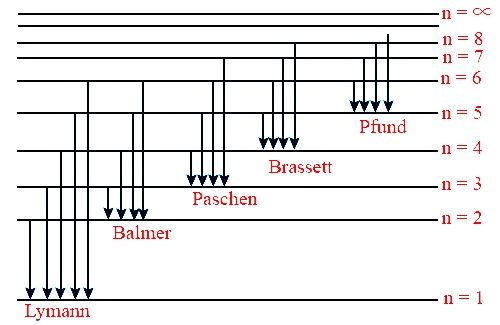
Calculate the wavelength from Balmer formula when n=3.
Answer
487.8k+ views
Hint: Try to use the Rydberg formula and derive the Balmer formula from there. There I have an equation that relates Rydberg constant, wavelength and the number of orbits the electron jumps into.
Complete step-by step answer:
In order to answer our question, we need to know about the line spectrum. The hydrogen spectrum is an example of line emission spectrum. The line spectrum of hydrogen is obtained by passing an electric discharge through hydrogen as at low pressure. Hydrogen molecules split up into atoms. These electrons absorb energy and electrons get discharged. When these excited electrons come back to ground state they emit electromagnetic radiation of discrete frequencies. Now, when these emitted radiations are passed through prism then discontinuous line spectrum of several isolated sharp lines is observed. This is how the line spectrum of hydrogen looks like:

Now, the relation between wavelength and the number of spectral lines is:
So, we obtain
So, the wavelength of the Balmer series for n=3 is
NOTE: The following table shows the relation between the names of series, their ‘n’ values and their spectral region:
Complete step-by step answer:
In order to answer our question, we need to know about the line spectrum. The hydrogen spectrum is an example of line emission spectrum. The line spectrum of hydrogen is obtained by passing an electric discharge through hydrogen as at low pressure. Hydrogen molecules split up into atoms. These electrons absorb energy and electrons get discharged. When these excited electrons come back to ground state they emit electromagnetic radiation of discrete frequencies. Now, when these emitted radiations are passed through prism then discontinuous line spectrum of several isolated sharp lines is observed. This is how the line spectrum of hydrogen looks like:

Now, the relation between wavelength and the number of spectral lines is:
So, we obtain
So, the wavelength of the Balmer series for n=3 is
NOTE: The following table shows the relation between the names of series, their ‘n’ values and their spectral region:
| Series | Spectral Region | ||
| Lyman | 1 | 2,3,.. | Ultraviolet |
| Balmer | 2 | 3,4,.. | Visible |
| Paschen | 3 | 4,5,… | Infrared |
| Brackett | 4 | 5,6,… | Infrared |
| Pfund | 5 | 6,7,…. | Infrared |
Latest Vedantu courses for you
Grade 11 Science PCM | CBSE | SCHOOL | English
CBSE (2025-26)
School Full course for CBSE students
₹41,848 per year
Recently Updated Pages
Master Class 11 Economics: Engaging Questions & Answers for Success

Master Class 11 Business Studies: Engaging Questions & Answers for Success

Master Class 11 Accountancy: Engaging Questions & Answers for Success

Master Class 11 English: Engaging Questions & Answers for Success

Master Class 11 Computer Science: Engaging Questions & Answers for Success

Master Class 11 Maths: Engaging Questions & Answers for Success

Trending doubts
State and prove Bernoullis theorem class 11 physics CBSE

1 ton equals to A 100 kg B 1000 kg C 10 kg D 10000 class 11 physics CBSE

State the laws of reflection of light

One Metric ton is equal to kg A 10000 B 1000 C 100 class 11 physics CBSE

1 Quintal is equal to a 110 kg b 10 kg c 100kg d 1000 class 11 physics CBSE

Difference Between Prokaryotic Cells and Eukaryotic Cells




